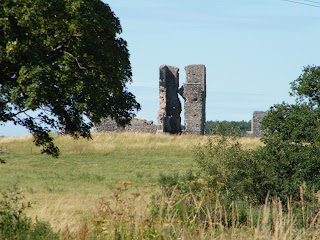But be patient, for you shall be rewarded. Go in the summer and there's every reason to expect hot, dry, sunny days, sandy beaches, quaint villages, and pubs. Lots of pubs. People? Not so many.
Here's what the beach looked like in July 2016:
I was there because I spent part of my teenage years living in the area, and I still have family and friends who live there. But this particular visit was a mission, too, as I was taking photos to go with a blog post on Norfolk in Little Domesday, a smaller part of the Domesday Survey of 1086.
My first stop was the village of Great Massingham, with its five village ponds, one of which used to be a clay pit, according to one of the local residents. The several ponds (I was told there are seven in total) belonged originally to the Augustinian priory.
and the remains of the medieval abbey incorporated into a more modern building.
In a nearby village, a nod to the Domesday survey can still be found. In 1086, Snettisham was recorded as having seven mills. Nowadays, the mill house sits tucked away from the main streets.
Just a short distance from Snettisham (where Iron Age gold torcs were unearthed) lie the coastal resorts of Heacham (where John Rolfe, husband of Pocahontas was born) and Hunstanton, which, along with its famous striped cliffs,
boasts an older part of town, Old Hunstanton, where this fourteenth-century church can be found:
For later grandeur, go back inland to Houghton Hall, built in the Palladian style for Robert Walpole, de facto first Prime Minister.
The house was built between 1722 and 1735
and is home to a herd of white deer (spot the interloper!)
Holt is a bustling town, which nevertheless betrays its origins, which also go back to the time of the Domesday survey. The picture below shows the only remaining trace of the market place:
(picture below is a close up of the building on the left of the above)
But Holt still boasts many buildings of architectural interest, including Gresham's School, founded in 1555 as a Grammar school for poor boys.
The origins of the town are shown on this sign:
Further along the coast are the 'Burnhams' - Burnham Market, Burnham Thorpe, Burnham Overy Staithe (below)
which are closely associated with Admiral Lord Nelson, who was born in Burnham Thorpe in 1758 and whose mother was a great-niece of Robert Walpole.
I visited only one small corner of the county, the north west, but there is plenty of history here, from grand stately homes, to ruined churches. Bawsey, below, is all that remains of an abandoned medieval village.
And for sheer period charm, there is the windmill at Great Bircham, open to the public, but seen here from a country lane:
The town of King's Lynn is worthy of a separate blog post, which is exactly what I will be giving it, at a later date.
But wait, didn't I say this was poppy country? It certainly is:
Meanwhile, if you wish to know more about the Little Domesday survey, and why Norfolk was not included in the main Domesday Book, go to the EHFA Blog
[all photographs by and copyright of the author]


















I see the church in Old Hunstanton every morning when I open my curtains.
ReplyDeleteHow wonderful! I worked up at Hunstanton for a year when I left school. I have such fond memories of it and I just can't wait for each summer to roll round so that I can go 'home' again.
Delete